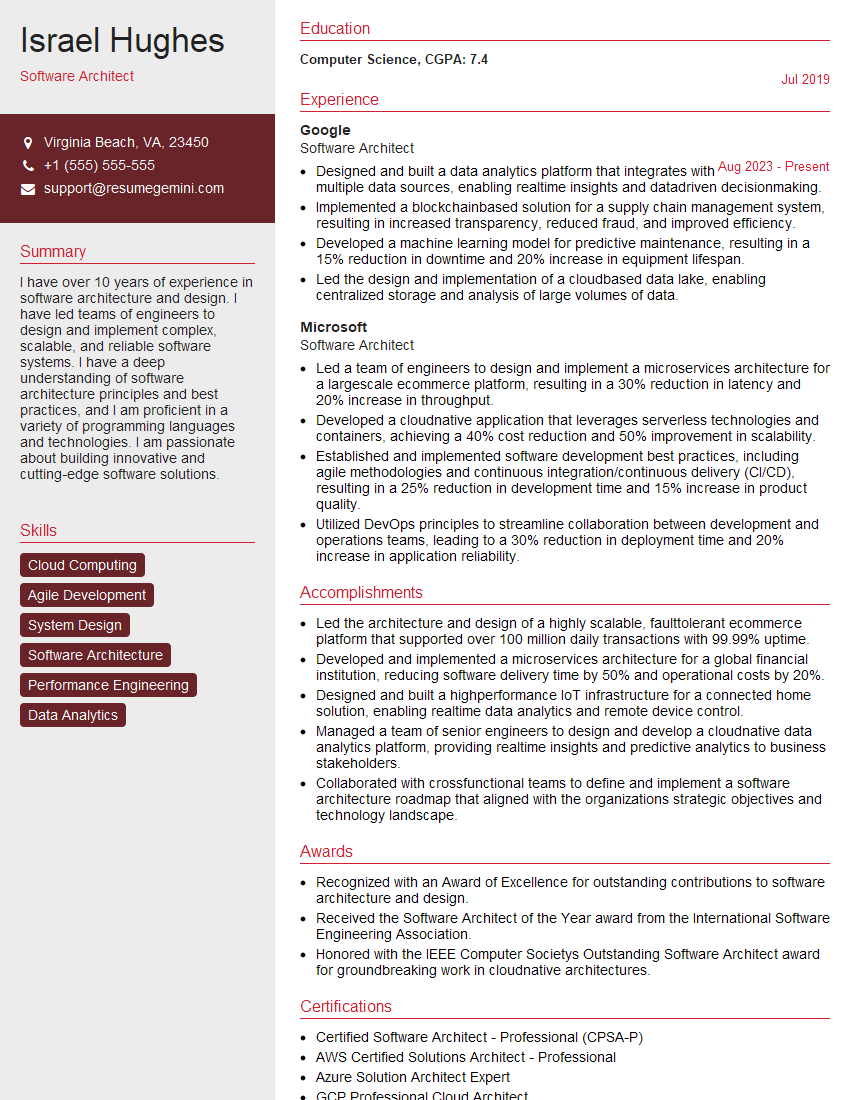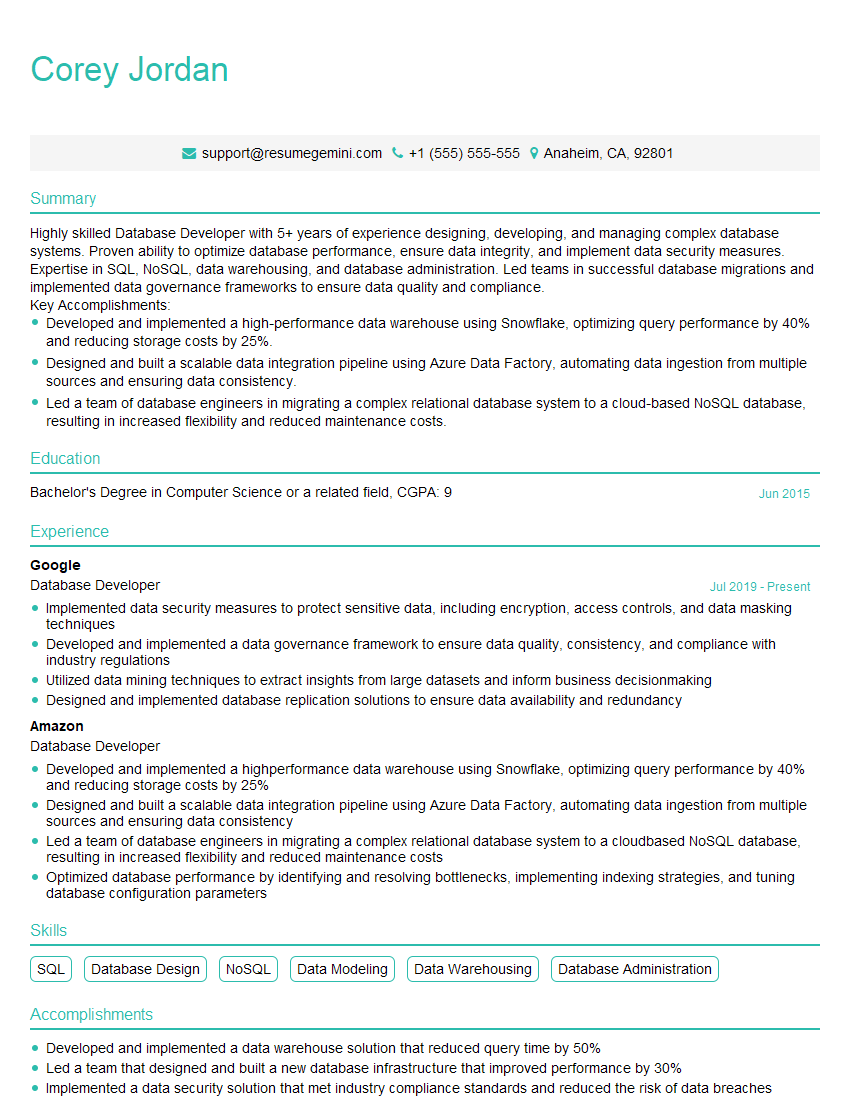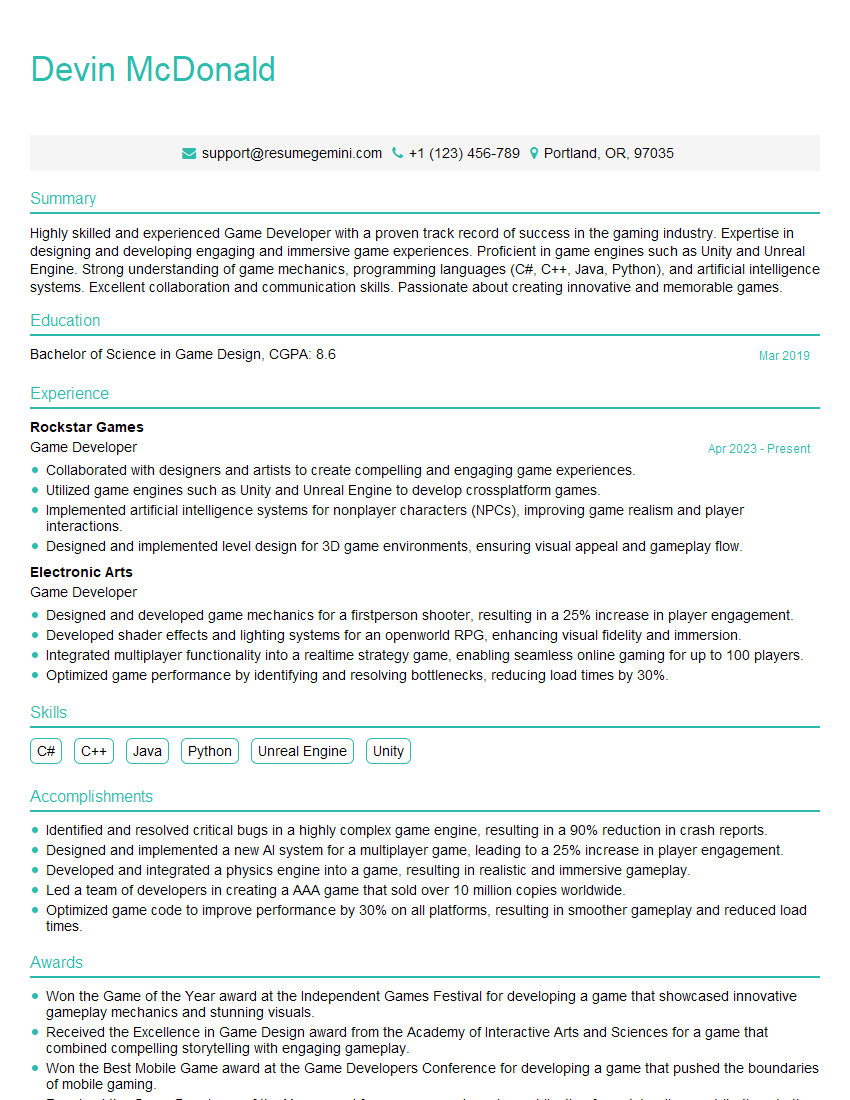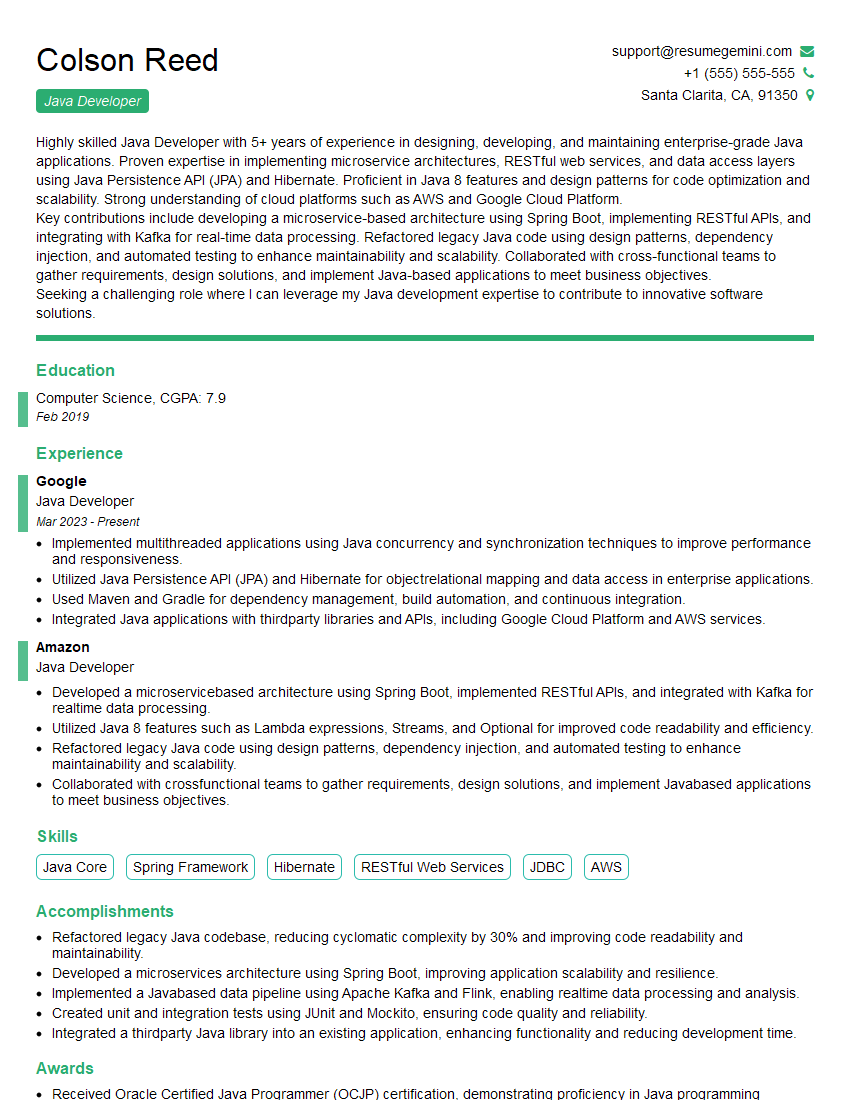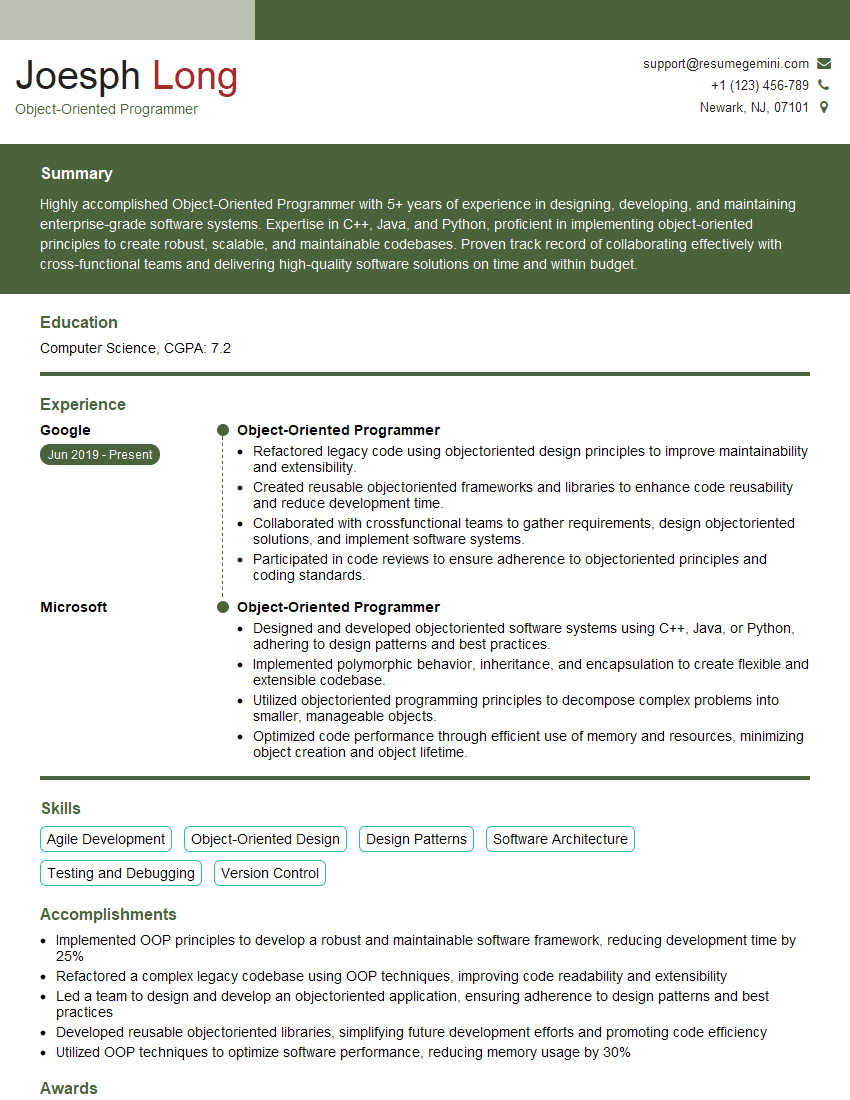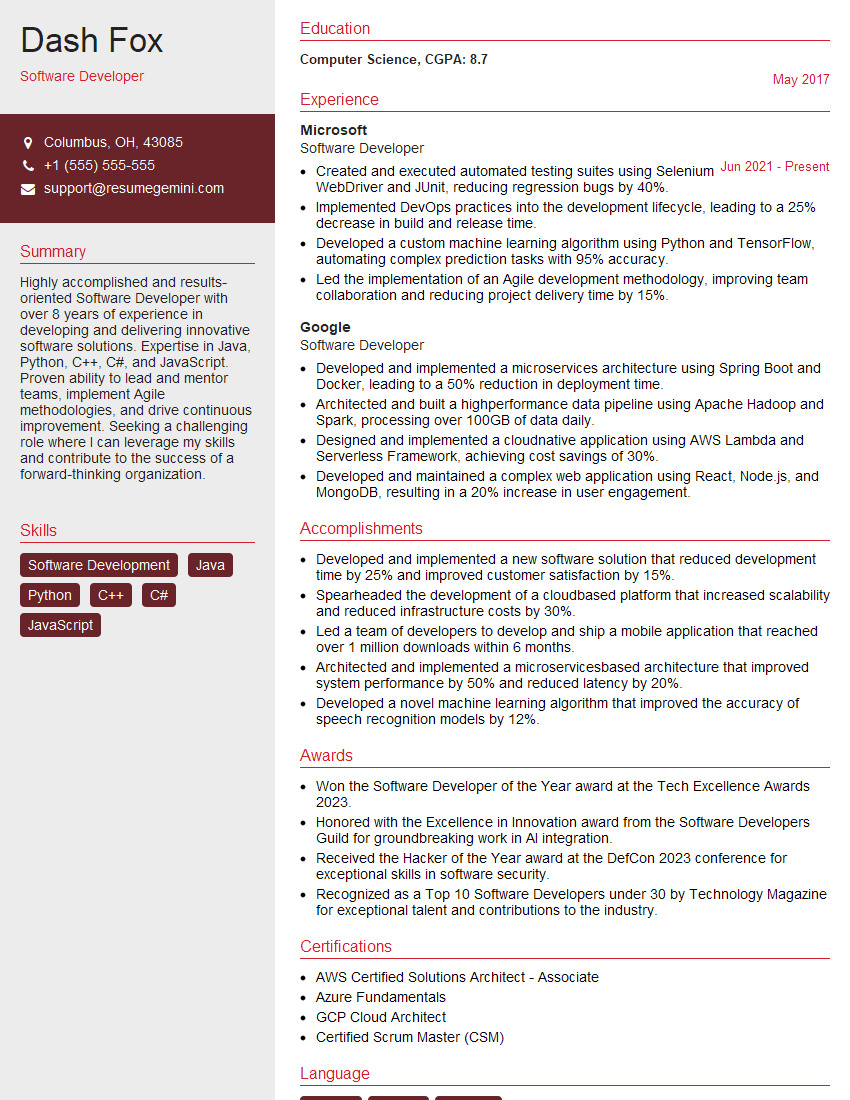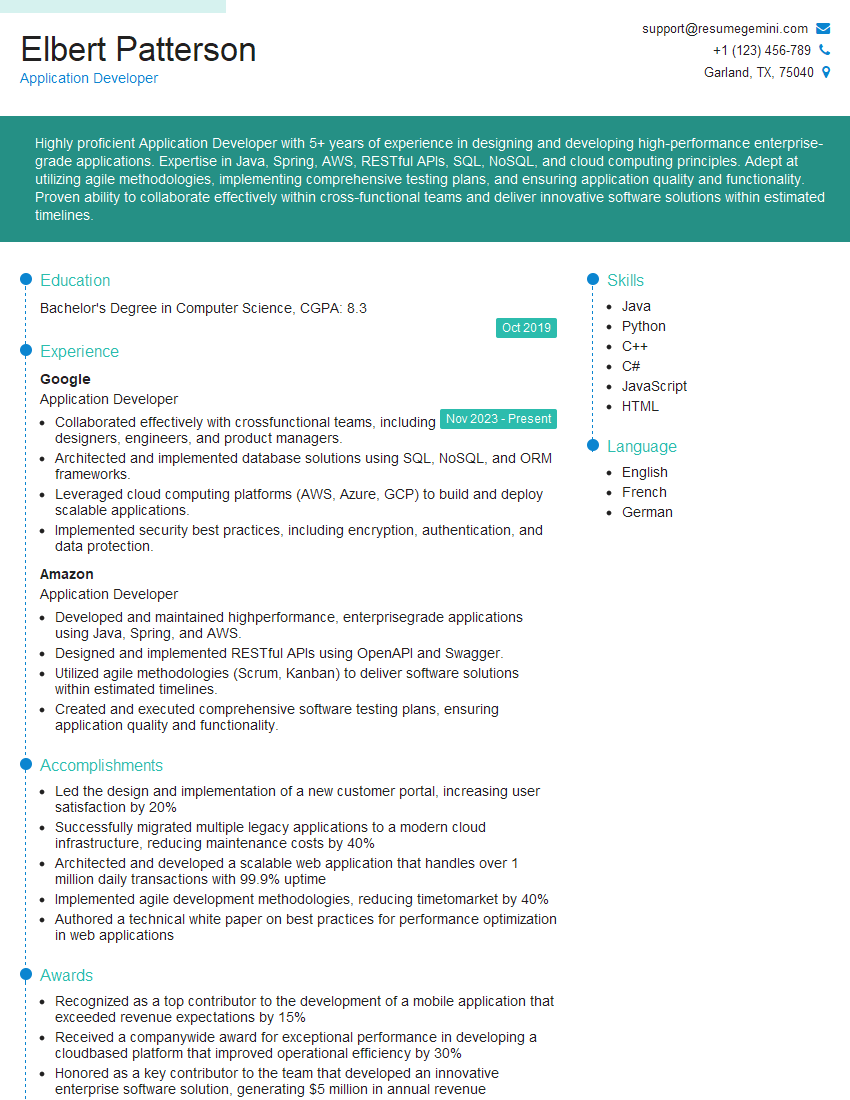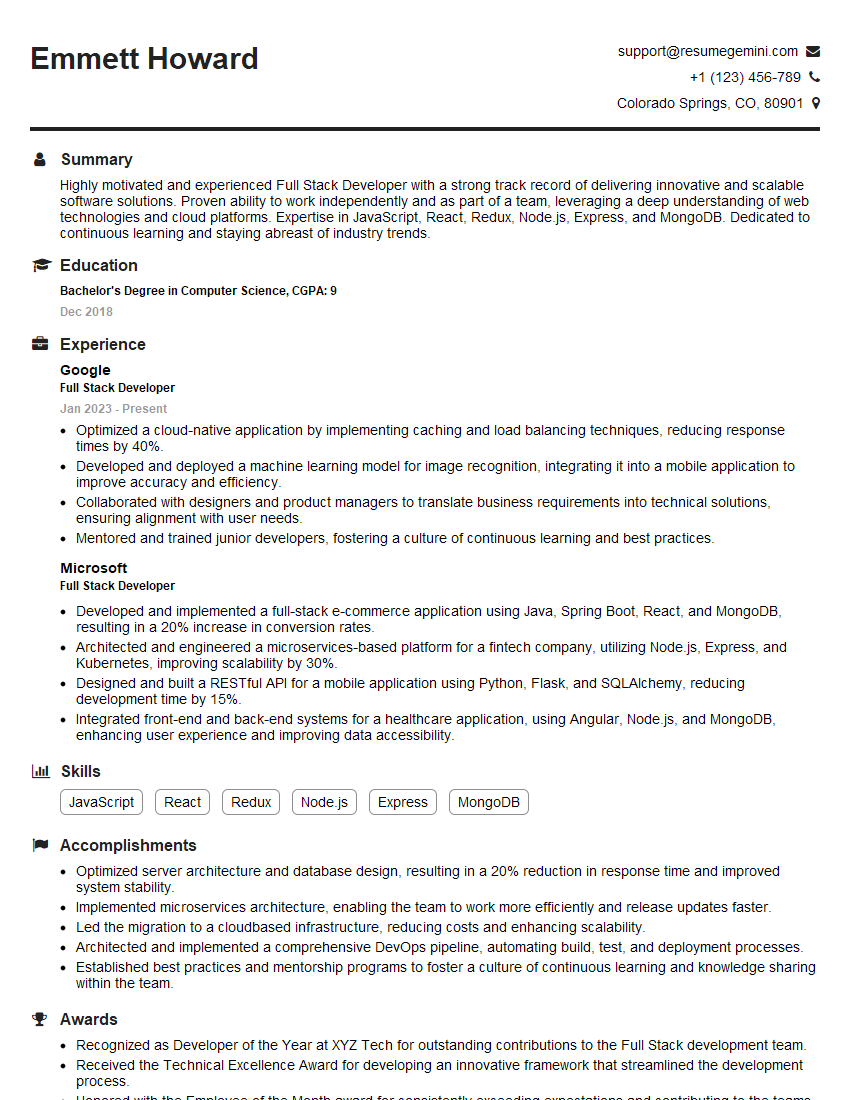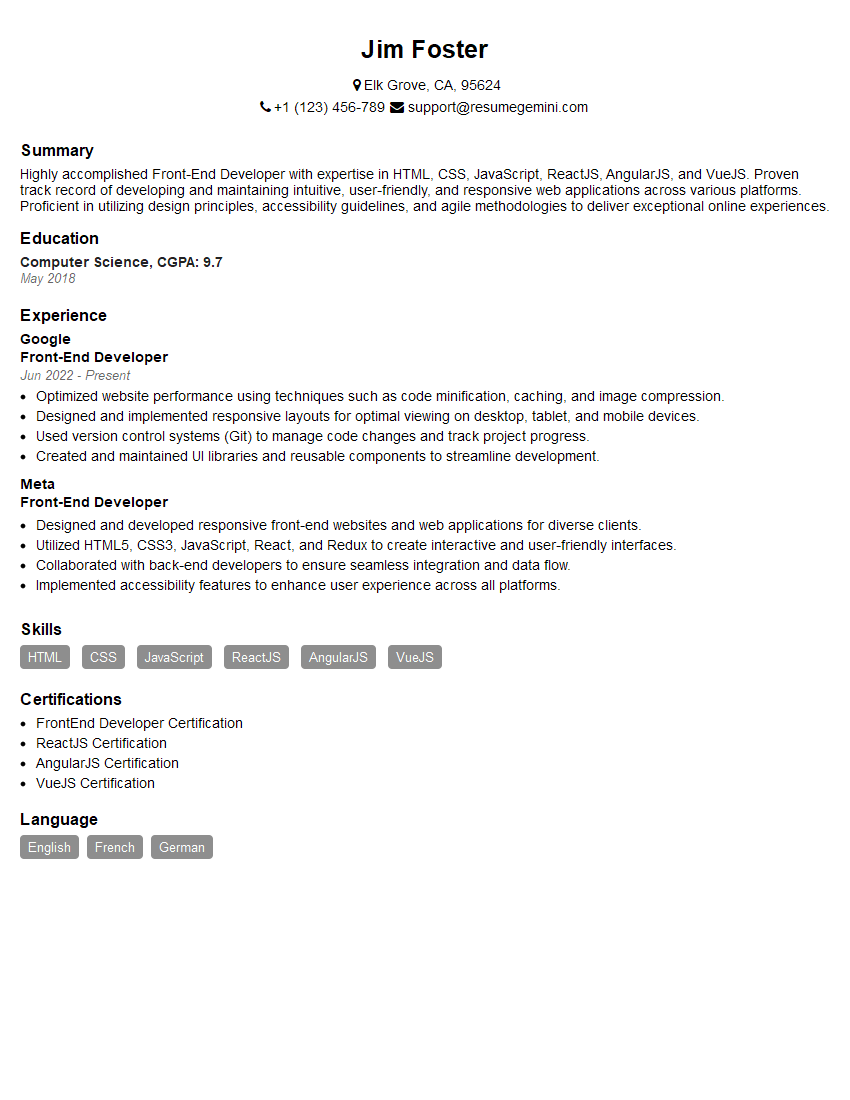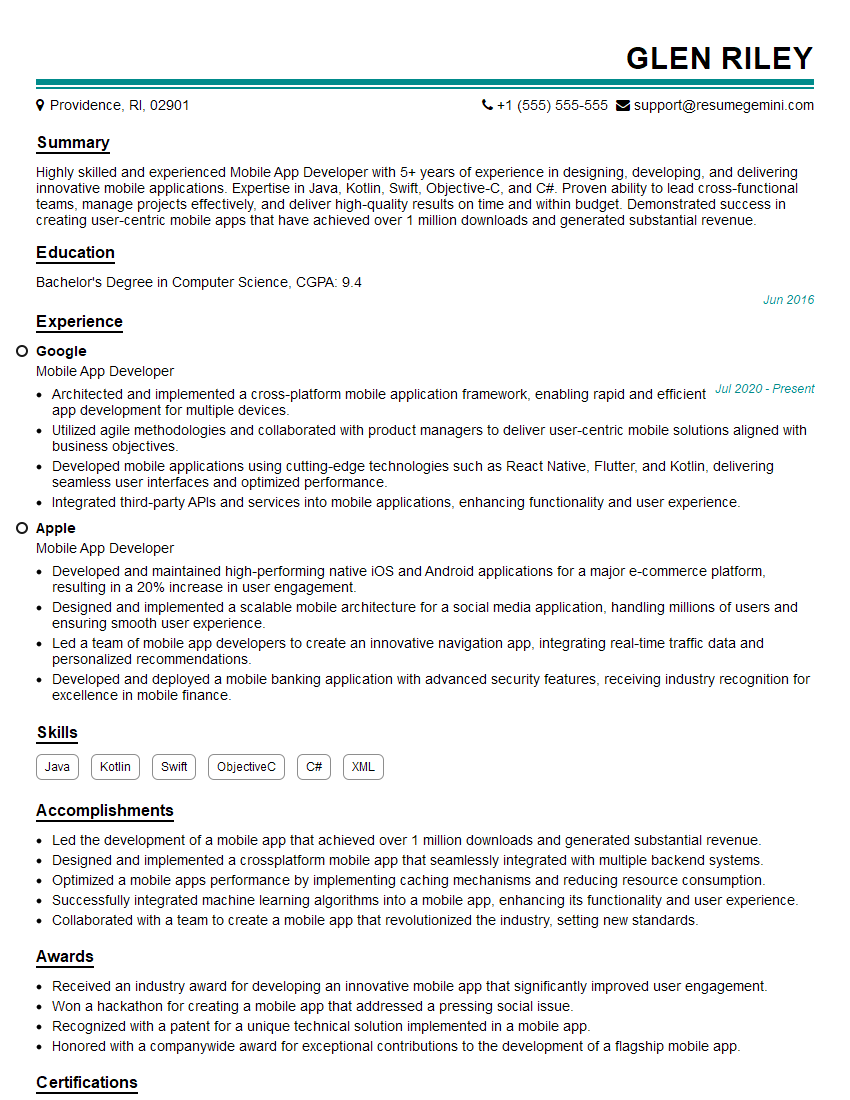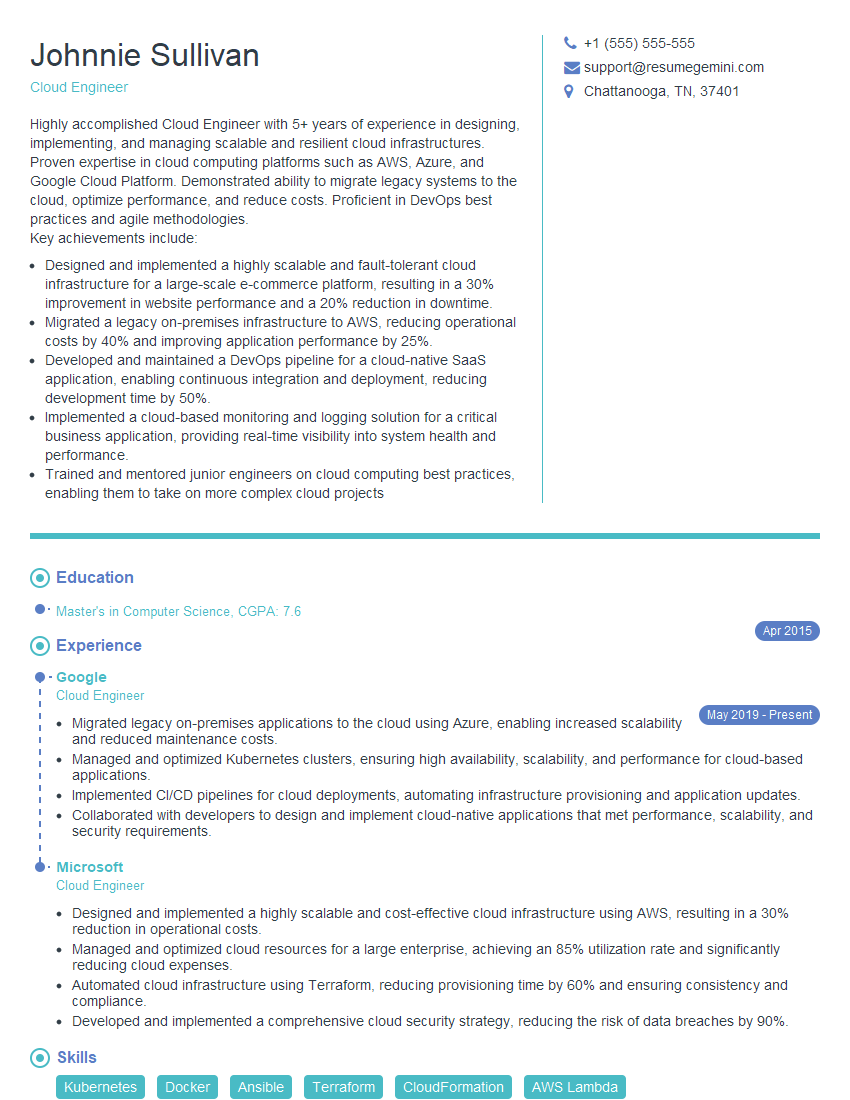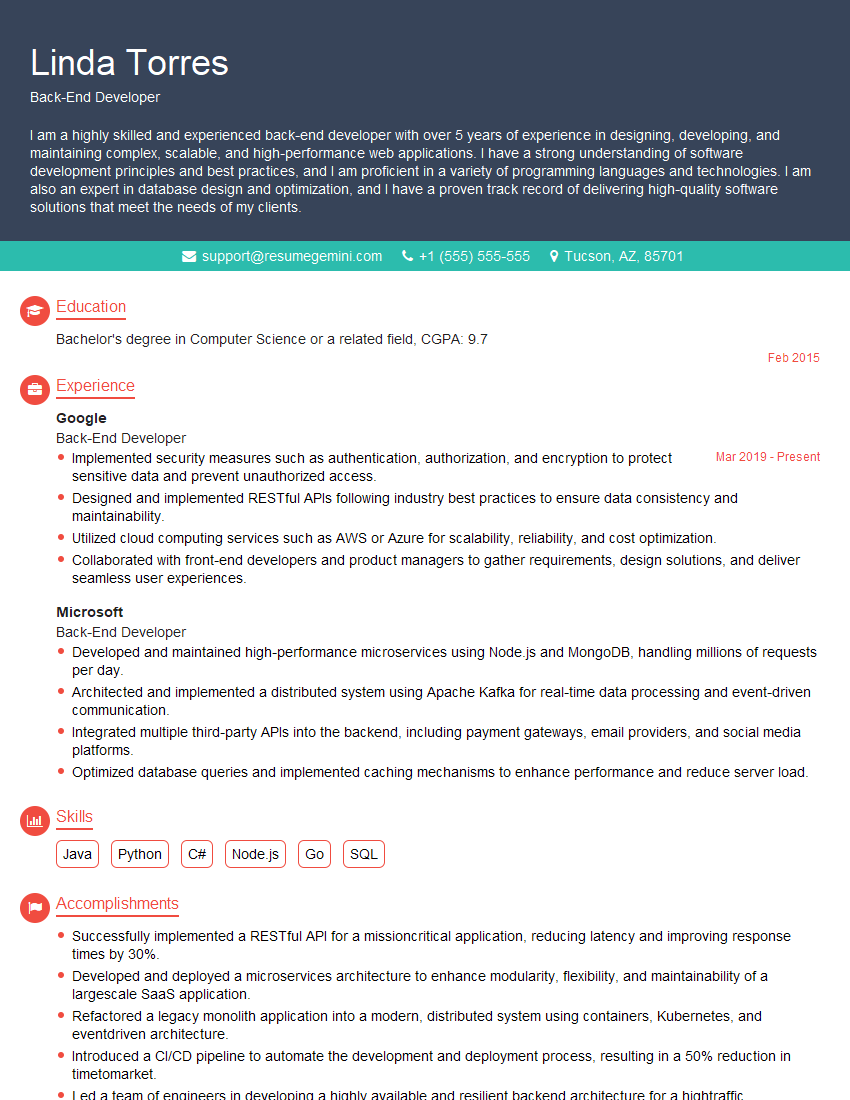Preparation is the key to success in any interview. In this post, we’ll explore crucial ObjectOriented Programming interview questions and equip you with strategies to craft impactful answers. Whether you’re a beginner or a pro, these tips will elevate your preparation.
Questions Asked in ObjectOriented Programming Interview
Q 1. Explain the four fundamental principles of Object-Oriented Programming.
Object-Oriented Programming (OOP) is a powerful programming paradigm built on four fundamental principles: Abstraction, Encapsulation, Inheritance, and Polymorphism. These principles work together to create modular, reusable, and maintainable code.
- Abstraction: Hiding complex implementation details and showing only essential information to the user. Think of a car – you drive it without needing to understand the intricacies of the engine. In code, this means exposing only necessary methods and hiding internal workings.
- Encapsulation: Bundling data (variables) and methods (functions) that operate on that data within a single unit, the class. This protects data integrity and prevents accidental modification. Imagine a capsule protecting medicine; similarly, encapsulation protects data.
- Inheritance: Creating new classes (child classes) from existing ones (parent classes), inheriting properties and behaviors. This promotes code reusability and establishes a hierarchical relationship between classes. Think of inheriting traits from your parents.
- Polymorphism: The ability of objects of different classes to respond to the same method call in their own specific way. This allows for flexibility and extensibility. Consider a ‘draw’ method – a circle would draw a circle, a square would draw a square.
Q 2. What is encapsulation and why is it important?
Encapsulation is the bundling of data and methods that operate on that data within a class, restricting direct access to some of the class’s components. This is achieved using access modifiers (like public, private, and protected).
Importance:
- Data Protection: Prevents accidental or unauthorized modification of data. This ensures data integrity and consistency.
- Code Maintainability: Changes to the internal implementation of a class don’t necessarily affect other parts of the program, as long as the public interface remains unchanged.
- Flexibility: Allows for easier modification and extension of the class without impacting other dependent classes.
Example: Consider a BankAccount class. Encapsulation would hide the balance directly while providing methods like deposit() and withdraw() to interact with it.
class BankAccount {
private double balance;
public void deposit(double amount) {
balance += amount;
}
public void withdraw(double amount) {
if (balance >= amount) {
balance -= amount;
} else {
//Handle insufficient funds
}
}
public double getBalance() {
return balance;
}
}Q 3. What is inheritance and how does it promote code reusability?
Inheritance is a mechanism where a new class (child class or derived class) is created from an existing class (parent class or base class). The child class inherits the properties (data) and methods (functions) of the parent class, and can also add its own unique properties and methods or override existing ones.
Code Reusability: Inheritance promotes code reusability by allowing you to reuse existing code instead of rewriting it. This saves time and effort, reduces redundancy, and improves code consistency.
Example: Imagine a Vehicle class with properties like color and speed. A Car class can inherit from Vehicle, adding properties like numberOfDoors and methods like honkHorn(). The Car class automatically gets the color and speed properties from Vehicle without needing to define them again.
class Vehicle {
String color;
int speed;
}
class Car extends Vehicle {
int numberOfDoors;
void honkHorn() {
//Implementation
}
}Q 4. Explain polymorphism and give a practical example.
Polymorphism, meaning “many forms,” is the ability of objects of different classes to respond to the same method call in their own specific way. This allows for flexibility and extensibility.
Practical Example: Consider a program that draws various shapes (circles, squares, triangles). Each shape class (Circle, Square, Triangle) could have a draw() method. When you call draw() on an object of each class, it will draw the appropriate shape. This is polymorphism in action; the same method name performs different actions based on the object type.
class Shape {
void draw() {
//Generic drawing
}
}
class Circle extends Shape {
@Override
void draw() {
//Draw a circle
}
}
class Square extends Shape {
@Override
void draw() {
//Draw a square
}
}Q 5. What is abstraction and its role in OOP?
Abstraction is the process of simplifying complex systems by modeling classes with only essential information. It focuses on what an object does, rather than how it does it. The implementation details are hidden from the user.
Role in OOP:
- Simplified Design: Makes complex systems easier to understand and manage by hiding unnecessary details.
- Increased Flexibility: Changes to the implementation of a class don’t necessarily affect the rest of the program, as long as the interface remains the same.
- Improved Code Reusability: Abstract classes and interfaces define a common structure that can be implemented by multiple concrete classes.
Example: A Car class might have methods like start(), accelerate(), and brake(). The user interacts with these methods without knowing the internal mechanisms of the engine or transmission. This is abstraction.
Q 6. Differentiate between composition and inheritance.
Inheritance and Composition are both ways to reuse code and establish relationships between classes, but they differ fundamentally:
- Inheritance (IS-A Relationship): Creates a hierarchical relationship where a child class inherits properties and methods from a parent class. A
Caris aVehicle. - Composition (HAS-A Relationship): Creates a relationship where a class contains instances of other classes as its members. A
Carhas aEngine,Wheels, etc.
Key Differences:
- Tight Coupling vs. Loose Coupling: Inheritance creates a tight coupling between classes, while composition offers looser coupling. Changes to the parent class in inheritance can significantly impact the child class. Composition allows for more flexibility.
- Single Inheritance Limitation: Many programming languages support only single inheritance (a class can inherit from only one parent), whereas composition allows for multiple relationships.
- Flexibility: Composition is generally considered more flexible and maintainable, as it avoids the limitations and potential problems of inheritance.
Example: Instead of inheriting from an Engine class, a Car class might use composition by having an Engine object as a member.
class Car {
Engine engine;
// ...
}Q 7. What are access modifiers (public, private, protected) and their uses?
Access Modifiers control the visibility and accessibility of class members (variables and methods). They are crucial for encapsulation and data protection.
public: Accessible from anywhere – inside or outside the class, from any other class.private: Accessible only from within the class itself. This is the strongest form of encapsulation.protected: Accessible from within the class itself, and also from subclasses (child classes) and other classes within the same package (in Java).
Uses:
- Data Hiding:
privatemembers ensure that data is accessed and modified only through methods of the class, protecting data integrity. - Code Organization: Access modifiers promote structured and well-organized code by controlling the visibility of class members.
- Flexibility:
protectedmembers allow for controlled access from subclasses, extending the functionality while maintaining encapsulation.
Example (Java):
class MyClass {
public int publicVar;
private int privateVar;
protected int protectedVar;
// ... methods ...
}
Q 8. Explain the concept of a class and an object.
In object-oriented programming, a class is like a blueprint for creating objects. Think of it as a template that defines the properties (data) and behaviors (methods) that objects of that class will have. It doesn’t represent a tangible entity itself; it’s a description of what an object will be.
An object, on the other hand, is an instance of a class. It’s a concrete realization of that blueprint. If the class is a blueprint for a house, then each individual house built from that blueprint is an object.
Example: Let’s say we have a class named Dog. This class might define properties like name, breed, and age, and methods like bark() and fetch(). When we create a specific dog, like a golden retriever named Buddy who is 3 years old, that’s an object of the Dog class.
class Dog {
String name;
String breed;
int age;
void bark() {
System.out.println("Woof!");
}
}
Dog buddy = new Dog();
buddy.name = "Buddy";
buddy.breed = "Golden Retriever";
buddy.age = 3;Q 9. What is an interface and how does it differ from an abstract class?
Both interfaces and abstract classes are used to achieve abstraction in OOP, but they differ significantly. An interface defines a contract; it specifies what methods a class *must* implement, without providing any implementation details. Think of it as a list of promises.
An abstract class, on the other hand, can provide some implementation details for certain methods *and* can also declare abstract methods (methods without a body) that subclasses *must* implement. It’s a more concrete base than an interface, providing partial functionality.
Key Differences:
- Implementation: Interfaces offer no implementation; abstract classes can provide some implementation.
- Inheritance: A class can implement multiple interfaces but can only extend (inherit from) one abstract class (in most languages).
- Members: Interfaces primarily define methods; abstract classes can also contain variables and static members.
Example (Java):
// Interface
interface Animal {
void makeSound();
}
// Abstract Class
abstract class Pet {
String name;
abstract void play();
void sleep(){ //Concrete method
System.out.println("Sleeping...");
}
}
// Implementation
class Dog implements Animal {
public void makeSound() { System.out.println("Woof!"); }
}
class Cat extends Pet{
@Override
void play(){
System.out.println("Playing with yarn");
}
}
Q 10. Describe different types of polymorphism (compile-time and runtime).
Polymorphism, meaning “many forms,” is a powerful OOP concept enabling objects of different classes to be treated as objects of a common type. This is achieved through method overriding and method overloading.
Compile-time Polymorphism (Static Polymorphism): This is resolved at compile time. It’s primarily achieved through method overloading – having multiple methods with the same name but different parameters within a class.
Example (Java):
class Calculator {
int add(int a, int b) { return a + b; }
double add(double a, double b) { return a + b; }
}
The compiler determines which add method to call based on the arguments passed.
Runtime Polymorphism (Dynamic Polymorphism): This is resolved at runtime. It’s achieved through method overriding – a subclass providing a specific implementation for a method already defined in its superclass.
Example (Java):
class Animal {
void makeSound() { System.out.println("Generic animal sound"); }
}
class Dog extends Animal {
@Override
void makeSound() { System.out.println("Woof!"); }
}
Animal myAnimal = new Dog(); // Polymorphic reference
myAnimal.makeSound(); // Calls Dog's makeSound() at runtime
The runtime environment decides which makeSound method to execute based on the object’s actual type (Dog in this case).
Q 11. What are design patterns and name three common ones.
Design patterns are reusable solutions to commonly occurring problems in software design. They provide proven templates and best practices for structuring code, improving maintainability, and promoting better collaboration among developers.
Three common design patterns are:
- Singleton: Ensures that only one instance of a class is created. Useful for managing resources like database connections or logging services.
- Factory: Provides an interface for creating objects without specifying the exact class being created. This promotes loose coupling and flexibility.
- Observer: Defines a one-to-many dependency between objects. When one object changes state, all its dependents are notified and updated automatically. Useful for things like event handling and UI updates.
Q 12. Explain the SOLID principles of object-oriented design.
The SOLID principles are five design principles intended to make software designs more understandable, flexible, and maintainable. They are:
- Single Responsibility Principle (SRP): A class should have only one reason to change. Each class should have one specific responsibility.
- Open/Closed Principle (OCP): Software entities (classes, modules, functions, etc.) should be open for extension but closed for modification. New functionality should be added without altering existing code.
- Liskov Substitution Principle (LSP): Subtypes should be substitutable for their base types without altering the correctness of the program. This ensures that subclasses behave as expected when used in place of their parent classes.
- Interface Segregation Principle (ISP): Clients should not be forced to depend upon interfaces they don’t use. Break large interfaces into smaller, more specific ones.
- Dependency Inversion Principle (DIP): High-level modules should not depend on low-level modules. Both should depend on abstractions. Abstractions should not depend on details. Details should depend on abstractions. This reduces coupling and increases flexibility.
Q 13. How do you handle exceptions in your code?
Exception handling is crucial for writing robust and reliable code. It involves anticipating potential errors and gracefully handling them to prevent program crashes. In most languages, this is done using try-catch blocks (or similar constructs).
Example (Java):
try {
// Code that might throw an exception
int result = 10 / 0; // Division by zero
} catch (ArithmeticException e) {
// Handle the exception
System.err.println("Error: Division by zero: " + e.getMessage());
} finally {
// Code that always executes (cleanup)
System.out.println("This always runs");
}
The try block encloses the code that might throw an exception. The catch block specifies the type of exception to catch and handles it appropriately. The finally block (optional) contains code that executes regardless of whether an exception occurred, often used for resource cleanup (closing files, releasing network connections, etc.).
It’s good practice to handle specific exception types rather than using a generic catch (Exception e), as this allows for more targeted error handling and debugging.
Q 14. What is the difference between static and non-static methods?
The difference between static and non-static methods lies in how they relate to objects and the class itself.
Non-static methods (instance methods): These methods belong to individual objects of a class. They operate on the object’s data (instance variables) and can access and modify them. They are called using an object reference.
Static methods (class methods): These methods belong to the class itself, not to any specific object. They don’t have access to instance variables; they can only access static variables and other static methods of the class. They are called directly using the class name.
Example (Java):
class MyClass {
int instanceVar = 10; // Instance variable
static int staticVar = 20; // Static variable
void instanceMethod() {
System.out.println(instanceVar);
}
static void staticMethod() {
System.out.println(staticVar);
}
}
MyClass obj = new MyClass();
obj.instanceMethod(); // Call instance method
MyClass.staticMethod(); // Call static method
Q 15. Explain the concept of method overloading and overriding.
Method overloading and overriding are powerful features in object-oriented programming that enhance code flexibility and reusability, but they differ significantly. Let’s break them down:
Method Overloading:
Overloading refers to having multiple methods within the same class with the same name but different parameters. The compiler distinguishes between these methods based on the number, type, or order of arguments. Think of it like having multiple versions of a single tool, each designed for a slightly different task.
public class Calculator {
public int add(int a, int b) { return a + b; }
public double add(double a, double b) { return a + b; }
public int add(int a, int b, int c) { return a + b + c; }
}
In this example, the add method is overloaded three times. The compiler determines which version to use based on the arguments provided during the method call.
Method Overriding:
Overriding, on the other hand, occurs when a subclass provides a specific implementation for a method that is already defined in its superclass. This allows a subclass to modify or extend the behavior of an inherited method. It’s like taking a pre-built tool and customizing it to fit your specific needs.
class Animal {
public void makeSound() { System.out.println("Generic animal sound"); }
}
class Dog extends Animal {
@Override
public void makeSound() { System.out.println("Woof!"); }
}
Here, Dog overrides the makeSound method inherited from Animal. When you call makeSound on a Dog object, it prints “Woof!” instead of the generic animal sound.
Key Difference: Overloading happens within the same class, while overriding happens between a superclass and a subclass. Overloading focuses on parameter differences; overriding focuses on providing a different implementation.
Career Expert Tips:
- Ace those interviews! Prepare effectively by reviewing the Top 50 Most Common Interview Questions on ResumeGemini.
- Navigate your job search with confidence! Explore a wide range of Career Tips on ResumeGemini. Learn about common challenges and recommendations to overcome them.
- Craft the perfect resume! Master the Art of Resume Writing with ResumeGemini’s guide. Showcase your unique qualifications and achievements effectively.
- Don’t miss out on holiday savings! Build your dream resume with ResumeGemini’s ATS optimized templates.
Q 16. What is constructor chaining?
Constructor chaining is a technique that allows one constructor to call another constructor within the same class. This promotes code reusability and reduces redundancy. Imagine building a house – instead of building every room from scratch for each new house, you might use pre-built modules (like pre-fabricated bathrooms or kitchens).
There are two main ways to achieve constructor chaining:
- Using
this()keyword: This calls another constructor within the same class. It must be the first statement in the constructor. - Using
super()keyword: This calls a constructor from the superclass. It must also be the first statement.
public class Person {
String name;
int age;
public Person(String name) {
this(name, 0); // Calls the other constructor
}
public Person(String name, int age) {
this.name = name;
this.age = age;
}
}
In this example, the first constructor delegates the initialization to the second constructor, making the code cleaner and preventing duplication.
Q 17. Describe the concept of data hiding and its benefits.
Data hiding, also known as encapsulation, is a fundamental principle in object-oriented programming that protects an object’s internal state from unauthorized access or modification. It’s like a well-guarded fortress, only allowing access through designated checkpoints. This improves the security and maintainability of your code.
Benefits of Data Hiding:
- Increased security: Prevents accidental or malicious modification of an object’s internal data.
- Improved maintainability: Changes to the internal implementation of a class don’t necessarily affect other parts of the program.
- Enhanced code reusability: Classes with well-defined interfaces are easier to reuse and integrate into different projects.
- Reduced complexity: Data hiding simplifies the overall architecture by abstracting away internal details.
Implementation: Data hiding is typically implemented using access modifiers like private, protected, and public. private members are only accessible within the same class, whereas public members are accessible from anywhere. protected members are accessible within the same package and by subclasses.
public class BankAccount {
private double balance;
public void deposit(double amount) { balance += amount; }
public void withdraw(double amount) { balance -= amount; }
public double getBalance() { return balance; }
}
In this example, balance is private, preventing direct access from outside the class. Access and modification are controlled through the deposit, withdraw, and getBalance methods, ensuring data integrity.
Q 18. How do you implement the singleton design pattern?
The Singleton pattern ensures that a class has only one instance and provides a global point of access to it. This is useful for managing resources that should only exist once, such as a database connection or a logging service. Think of it like a single, central control room.
Here’s how you can implement the Singleton pattern in Java, using a static instance and a private constructor:
public class Singleton {
private static final Singleton INSTANCE = new Singleton();
private Singleton() {}
public static Singleton getInstance() {
return INSTANCE;
}
// Other methods
}
The private constructor prevents external instantiation. The static INSTANCE variable holds the single instance, and the getInstance() method provides controlled access.
Important Considerations:
- Thread Safety: In a multithreaded environment, consider using double-checked locking or a static initializer block to ensure thread-safe instantiation.
- Serialization: You might need to implement
readResolve()to prevent multiple instances when deserializing a Singleton object. - Testability: Singletons can make testing more challenging. Consider using dependency injection to improve testability.
Q 19. What are the advantages and disadvantages of using inheritance?
Inheritance is a fundamental concept in object-oriented programming that allows classes to inherit properties and methods from their parent classes. It’s like creating blueprints – you start with a basic design and then specialize it for different variations. However, like any powerful tool, it has both advantages and disadvantages.
Advantages:
- Code Reusability: Avoids redundant code by reusing properties and methods from parent classes. This saves time and effort and improves maintainability.
- Improved Code Organization: Organizes code into a clear hierarchy, making it easier to understand and manage.
- Polymorphism: Allows objects of different classes to be treated as objects of a common type, which is crucial for writing flexible and extensible code.
Disadvantages:
- Tight Coupling: Subclasses become tightly coupled to their superclasses, making changes in the superclass potentially affect subclasses.
- Fragile Base Class Problem: Changes in the superclass might break the functionality of subclasses if not carefully considered.
- Inheritance Abuse: Overuse of inheritance can lead to complex and difficult-to-understand class hierarchies.
Practical Considerations: Favor composition over inheritance whenever possible, as composition provides more flexibility and reduces coupling. Inheritance should be used judiciously, primarily for ‘is-a’ relationships where the subclass truly represents a specialized type of the superclass.
Q 20. Explain the concept of dependency injection.
Dependency Injection (DI) is a design pattern that separates the creation of objects from their usage. Instead of an object creating its own dependencies, these dependencies are ‘injected’ into the object from the outside. This leads to looser coupling, increased modularity, and enhanced testability. Imagine ordering a meal at a restaurant – you don’t need to know how the kitchen prepares the food; you just receive the finished product.
Benefits of DI:
- Loose Coupling: Reduces dependencies between classes, making the code more flexible and maintainable.
- Improved Testability: Easier to test individual components in isolation by injecting mock dependencies.
- Enhanced Reusability: Components can be easily reused in different contexts by injecting different dependencies.
Implementation: There are three main types of DI:
- Constructor Injection: Dependencies are passed through the constructor.
- Setter Injection: Dependencies are passed through setter methods.
- Interface Injection: Dependencies are passed through an interface method.
// Constructor Injection
public class MyClass {
private Dependency myDependency;
public MyClass(Dependency dependency) { this.myDependency = dependency; }
}
In this example, the MyClass object receives its dependency via the constructor, making it clear what it needs.
Q 21. What is a factory pattern and when would you use it?
The Factory pattern is a creational design pattern that provides an interface for creating objects without specifying their concrete classes. It’s like having a central factory that produces different types of products based on your request, without you needing to know the exact manufacturing process. This promotes loose coupling and makes it easy to add new object types without modifying existing code.
When to use the Factory Pattern:
- When you need to create objects of different classes based on some criteria. For example, creating different types of buttons (e.g., Windows button, macOS button) based on the operating system.
- When you want to decouple object creation from the client code. The client code doesn’t need to know the concrete classes being created.
- When you want to encapsulate the object creation logic. This makes it easier to change the object creation process without affecting the client code.
interface Button {
void click();
}
class WindowsButton implements Button {
@Override public void click() { System.out.println("Windows click"); }
}
class MacButton implements Button {
@Override public void click() { System.out.println("Mac click"); }
}
class ButtonFactory {
public static Button createButton(String os) {
if (os.equals("windows")) return new WindowsButton();
else if (os.equals("mac")) return new MacButton();
else return null; // Or throw exception
}
}
The ButtonFactory creates different Button objects based on the operating system, hiding the concrete class creation from the client code.
Q 22. What is the difference between a List and a Set in Java?
In Java, both List and Set are interfaces belonging to the Collections Framework, used to store groups of objects. However, they differ significantly in how they manage these objects and their key characteristics.
- List: A
Listis an ordered collection that allows duplicate elements. Think of it like a numbered list; elements are stored in a specific sequence, and you can access them by their index (position). TheArrayListandLinkedListare common implementations of theListinterface. - Set: A
Setis an unordered collection that does not allow duplicate elements. Imagine a bag of unique marbles; each marble is distinct, and their order doesn’t matter. TheHashSetandTreeSetare common implementations of theSetinterface.
Example:
List namesList = new ArrayList<>();
namesList.add("Alice");
namesList.add("Bob");
namesList.add("Alice"); // Duplicate allowed
System.out.println(namesList); // Output: [Alice, Bob, Alice]
Set namesSet = new HashSet<>();
namesSet.add("Alice");
namesSet.add("Bob");
namesSet.add("Alice"); // Duplicate ignored
System.out.println(namesSet); // Output: [Alice, Bob] (order may vary)
Choosing between a List and a Set depends on your application’s needs. If order matters or duplicates are necessary, use a List. If uniqueness is crucial and order is unimportant, a Set is more efficient.
Q 23. Explain the concept of garbage collection.
Garbage collection is an automatic memory management feature in many modern programming languages, including Java and C#. It’s a crucial part of preventing memory leaks and improving application stability.
Imagine your program’s memory as a large workspace. When you create objects, you’re essentially allocating space in this workspace. Garbage collection is like a cleanup crew that periodically sweeps through the workspace, identifying objects that are no longer being used (referenced by your program) and reclaiming the memory they occupied. This frees up resources and prevents the workspace from becoming cluttered and eventually unusable.
The process usually involves three main phases: Marking, Sweeping, and Compaction. Marking identifies live objects (those still in use), sweeping removes the unreachable objects, and compaction rearranges the remaining objects to reduce fragmentation.
Benefits of Garbage Collection:
- Prevents memory leaks: Without garbage collection, unused objects would remain in memory indefinitely, leading to performance degradation and eventually application crashes.
- Simplifies development: Developers don’t need to manually manage memory allocation and deallocation, making code easier to write and maintain.
- Improves reliability: Reduces the risk of errors related to manual memory management.
However, it’s important to note that garbage collection adds some overhead. The frequency and performance of garbage collection can affect application performance; therefore, understanding how your language handles it and potentially optimizing your code for efficient garbage collection is beneficial.
Q 24. How do you implement unit testing in OOP?
Unit testing in OOP involves writing small, isolated tests that verify the functionality of individual units of code, typically methods or classes. The goal is to ensure each part works correctly before combining them.
Process:
- Identify Units: Determine the smallest testable pieces of your code (methods, classes).
- Write Test Cases: Create test methods for each unit, covering various scenarios including normal operation, edge cases (boundary conditions), and error handling.
- Use a Testing Framework: Frameworks like JUnit (Java) or NUnit (C#) provide tools for creating and running tests, managing test suites, and generating reports.
- Assertion Statements: Use assertion statements within your test methods to compare expected results with actual results. For example,
assertEquals()in JUnit. - Run Tests: Execute the tests and analyze the results. A successful test suite indicates that your units work as expected.
Example (JUnit):
@Test
public void testAddMethod() {
Calculator calc = new Calculator();
assertEquals(5, calc.add(2, 3));
assertEquals(0, calc.add(-1, 1));
}
Unit testing is crucial for building robust and maintainable OOP systems. It helps catch bugs early, simplifies debugging, improves code quality and reduces the risk of introducing errors during future changes.
Q 25. What is the difference between abstract classes and interfaces in Java/C#?
Both abstract classes and interfaces define blueprints for classes, but they differ significantly in their capabilities and usage.
- Abstract Class: An abstract class can contain both abstract methods (methods without implementation) and concrete methods (methods with implementation). A class that inherits from an abstract class must provide implementations for all its abstract methods. Abstract classes can have instance variables and constructors.
- Interface: An interface, in Java and C#, is a contract that specifies a set of methods that a class must implement. Interfaces do not have any concrete methods or instance variables. They primarily define behavior without specifying implementation details. In C#, interfaces can have properties, events, and indexers along with methods.
Key Differences Summarized:
| Feature | Abstract Class | Interface |
|---|---|---|
| Methods | Can have abstract and concrete methods | Only abstract methods (implicitly in Java, explicitly in C#) |
| Variables | Can have instance variables | Cannot have instance variables (Java) / Can have constants (C#) |
| Inheritance | Single inheritance (Java), Multiple inheritance (C#) | Multiple inheritance |
| Constructors | Can have constructors | Cannot have constructors |
Choosing Between Them:
Use an abstract class when you want to provide some common implementation details along with a shared interface. Use an interface when you want to define a contract that can be implemented by multiple unrelated classes. In many cases, interfaces are preferred for promoting better loose coupling and code flexibility.
Q 26. Describe your experience with different design patterns (e.g., MVC, MVVM).
I have extensive experience with several design patterns, most notably MVC (Model-View-Controller) and MVVM (Model-View-ViewModel). I’ve applied these in various projects ranging from web applications to desktop applications.
MVC (Model-View-Controller): I’ve used MVC extensively in web development projects. I appreciate its clear separation of concerns: The model handles data and business logic, the view renders the user interface, and the controller manages user interactions, updates the model, and selects the appropriate view. This separation simplifies development, testing, and maintenance. For example, I used MVC in a Spring Boot project to develop a RESTful API and frontend application. The separation of concerns was especially beneficial when we needed to update different parts of the application independently.
MVVM (Model-View-ViewModel): I find MVVM to be particularly useful in applications with complex UI interactions, especially when dealing with data binding. The ViewModel acts as an intermediary between the Model and the View, simplifying data handling and making the View much simpler to implement. For instance, in a WPF (Windows Presentation Foundation) project, I utilized MVVM to create a highly responsive and maintainable user interface that readily updates according to user interactions.
Besides these, I am also familiar with other patterns such as Singleton, Factory, Observer, and Decorator, and I select the appropriate pattern based on the specific problem and project requirements.
Q 27. Explain your approach to debugging and troubleshooting OOP code.
My approach to debugging OOP code is systematic and iterative. It involves a combination of techniques to efficiently identify and resolve issues.
Step-by-step approach:
- Reproduce the bug: Carefully document the steps required to reproduce the bug consistently. This is crucial for understanding and fixing the problem.
- Use logging and debugging tools: Utilize the debugger (e.g., Eclipse, Visual Studio debugger) to step through the code, inspect variables, and identify problematic lines. Insert logging statements throughout your code to track variable values and execution flow.
- Isolate the problem: Try to identify the specific class or module where the bug originated. Use unit tests to focus your attention on the affected parts of your code.
- Examine the stack trace: When an exception is thrown, carefully analyze the stack trace. It provides vital clues about the sequence of method calls that led to the error.
- Understand Object States: In OOP, the state of your objects is important. Check the values of object attributes at different points in the code’s execution to see if their state aligns with your expectations.
- Refactor if necessary: If the bug highlights a flaw in the design or implementation, refactoring may be necessary to improve the code’s structure and address the root cause.
This systematic and methodical approach significantly enhances efficiency, allowing for quick detection and resolution of bugs, leading to a more robust and reliable application.
Q 28. Describe a situation where you had to refactor legacy OOP code.
In a previous project, I had to refactor a large legacy C# application with a monolithic architecture and tightly coupled components. The code was poorly documented, difficult to maintain, and prone to frequent errors.
Refactoring Process:
- Analysis: I started by carefully analyzing the existing codebase to identify areas of concern. I created diagrams to visualize the relationships between classes and modules. This provided a high-level understanding of the system’s structure.
- Modularization: I broke down the monolithic system into smaller, independent modules with well-defined interfaces. This involved refactoring existing classes and creating new ones to achieve better separation of concerns.
- Dependency Injection: To reduce coupling, I introduced dependency injection. This allowed modules to interact through well-defined interfaces, improving testability and maintainability.
- Unit Testing: I implemented a comprehensive unit testing suite. This helped to ensure that the refactoring process didn’t introduce new bugs. This was crucial as the legacy code had minimal or no tests.
- Incremental Changes: I approached the refactoring process incrementally. I made small, well-tested changes, committing frequently. This helped to control the risk and allowed for easy rollback if necessary.
The result was a significantly improved system that was easier to maintain, extend, and test. The refactoring process also dramatically increased developer productivity.
Key Topics to Learn for Object-Oriented Programming Interviews
- Core Principles: Understand the four fundamental pillars of OOP: Abstraction, Encapsulation, Inheritance, and Polymorphism. Grasp their theoretical definitions and be prepared to illustrate them with practical examples.
- Class Design and Implementation: Practice designing robust and efficient classes, including the proper use of constructors, methods, and attributes. Be ready to discuss design patterns and their applications.
- Inheritance and Polymorphism: Master the concepts of inheritance (single, multiple, and hierarchical) and polymorphism (method overriding and overloading). Be prepared to explain the benefits and drawbacks of each.
- Data Structures and Algorithms: Familiarize yourself with common data structures (arrays, linked lists, trees, graphs) and algorithms (searching, sorting) within an OOP context. Understand how to implement these efficiently using OOP principles.
- Object Relationships: Understand different types of relationships between objects (association, aggregation, composition) and how to model them effectively in your code.
- Design Patterns: Explore common design patterns (e.g., Singleton, Factory, Observer) and understand when and how to apply them to solve specific programming problems. Be ready to discuss their advantages and disadvantages.
- Testing and Debugging: Develop strong debugging skills and understand various testing methodologies (unit testing, integration testing) to ensure the quality and robustness of your code.
- Problem-Solving Approach: Practice breaking down complex problems into smaller, manageable parts that can be solved using OOP principles. Develop a systematic approach to problem-solving.
Next Steps
Mastering Object-Oriented Programming is crucial for success in a wide range of software development roles. A strong understanding of OOP principles significantly enhances your problem-solving abilities and allows you to build scalable and maintainable software. To maximize your job prospects, create an ATS-friendly resume that clearly highlights your OOP skills and experience. ResumeGemini is a trusted resource to help you build a professional and impactful resume. They provide examples of resumes tailored to Object-Oriented Programming to guide you in crafting the perfect application. Take the next step towards your dream career – build a compelling resume that showcases your expertise!
Explore more articles
Users Rating of Our Blogs
Share Your Experience
We value your feedback! Please rate our content and share your thoughts (optional).
What Readers Say About Our Blog
Hi, I represent an SEO company that specialises in getting you AI citations and higher rankings on Google. I’d like to offer you a 100% free SEO audit for your website. Would you be interested?
Dear Sir/Madam,
Do you want to become a vendor/supplier/service provider of Delta Air Lines, Inc.? We are looking for a reliable, innovative and fair partner for 2025/2026 series tender projects, tasks and contracts. Kindly indicate your interest by requesting a pre-qualification questionnaire. With this information, we will analyze whether you meet the minimum requirements to collaborate with us.
Best regards,
Carey Richardson
V.P. – Corporate Audit and Enterprise Risk Management
Delta Air Lines Inc
Group Procurement & Contracts Center
1030 Delta Boulevard,
Atlanta, GA 30354-1989
United States
+1(470) 982-2456



